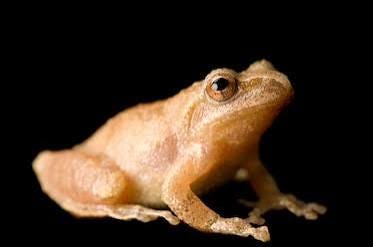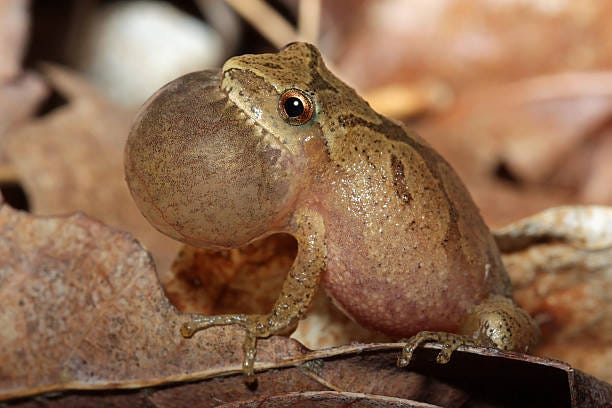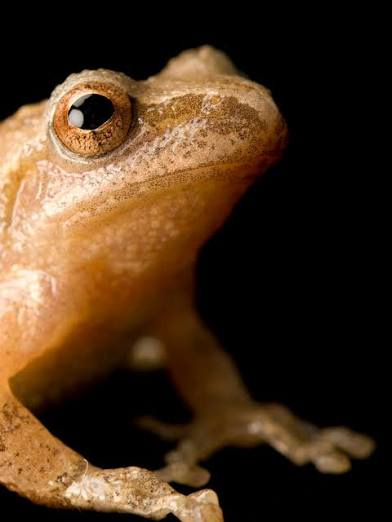At dusk on Monday night, I set out with two nature friends to a local vernal pool to see if we could catch a glimpse of newly awakened salamanders. The March full moon had just passed, and it had been raining for several days—encouraging signs that salamanders would be making their way to the water where they would mate and lay their eggs.
We were only a few steps onto the path when one friend said he could hear spring peepers. I thought I could hear something, but the sound blended with the traffic behind us and the rushing water over rocks ahead. But with each step we took toward the vernal pools, the sound of peeps, high and bright, grew louder, and it felt, suddenly, like we were in the middle of an orchestra, one where every musician was playing the same ascending note. PeeEEP, peeEEP, peeEEP. There must have been hundreds—thousands—of spring peepers in the trees. It felt as if the air were vibrating. It felt impossible, this joyous racket in the darkening woods. And I was wonderstruck. We stood before the pond, me and my two new nature friends, laughing at this joyful noise.
But we were there to see salamanders. We kept walking.
Soon, we were in full darkness. We turned around to retrace our steps, sweeping the paved path with our flashlights. Suddenly a loud peep! sounded right next to us.
We all squatted down. One friend flashed a light onto the saplings that grew on the water’s edge. Another carefully sifted through the leaf litter, delicately peeling away one wet leaf at a time. Nothing. Peepers, like crickets and grasshoppers, and probably every living thing that worries about predators, will grow silent in the presence of something larger than them. But not our peeper—every minute or so, he couldn’t help himself, and he let out a loud PeeEEP! I kept picturing the frog sitting on one of our shoulders, peeping into our ears, he was so loud, and so close.
And then my friend pushed aside another leaf—and there he was! All three centimeters of him. Brown like the color of the wet oak leaf he sat on.
How on earth could something this tiny make a sound so large? It was the first of many questions. Needless to say, I’ve spent the week reading about the wonder that is the spring peeper, and here are some of my favorite discoveries:
First, about that peep. A single peeper’s peep can reach 90 decibels! That means a spring peeper is louder than a leaf blower. The peeping is made by the males only, to attract mates, of course, because what tiny frog could resist that sound? and the more the male peeps, the more he mates. To make the loud peep, he takes air into his lungs, closes his nostrils and mouth, and pushes the air from his lungs over his vocal cords into the balloon-like pouch under his chin, which amplifies the sound. The sound of a peep can be heard as far as two and a half miles away! And the female peepers can discern one peep from another.
Spring peepers live most of their lives in the forest, in the trees and in the carpet of leaf litter. They come to sing by the water for mating season only, which lasts 2-3 months. They overwinter under logs, in holes, and under loose tree bark.
And peepers are freeze-resistant! They produce extra glucose that acts like antifreeze to keep ice crystals from forming in their cells. FASCINATING!
Most importantly, on Martha’s Vineyard, and only on Martha’s Vineyard, spring peepers are called PINKLETINKS. No one knows why.
FYI, I am also now going by the name Pinkletink.
We didn't see any salamanders that night*, but it was a perfect evening. Having friends who think it sounds fun to go walk in the woods at dusk to look for salamanders is a gift. There are many ways to connect with others, but I find connecting over a shared curiosity to be one of the most satisfying, and joyful.
And the experience left me thinking about the nature of awe. How you can’t go looking for wonderment, but you won’t encounter any surprises without taking a look at the world in front of you. I like to think of my walks as a practice of making myself available for delight, in whatever form that might take.
This reminds me of a stanza in the Mary Oliver poem, “Sometimes”.
Instructions for living a life:
Pay attention.
Be astonished.
Tell about it.
When I’m out walking, this sometimes feels like the path I’m on. When I’m outside, listening to the spring peepers sing, or watching a sparrow take a dust bath, or admiring the bright green tips of new growth on a conifer tree, this paying attention, this being available for the world, feels like enough.
PeeEEP!
Your friend,
Pinkletink
*One friend went back to the vernal pool that same night, wanting to share the joyful peeper experience with her husband, and they found the salamanders! I’m looking forward to going back soon!
I’d love to know what you are hearing on your walks! Share in the comments!
Try this: Keep a sound diary. Note what you are hearing on your usual walk, and how it changes with the weather, with the time of day, with the season. I love to walk with the Merlin app on sound ID, to learn what bird songs I am hearing.
Spring peepers are difficult to find, and even more difficult to photograph with an iPhone in the dark, so all photos in this edition are from free online sources. I spent many enjoyable minutes browsing through the results of a search for “free photos of spring peepers.” The striking photos with the black background are from National Geographic.









Beautiful post, Pinkletink!
I have the Merlin App, too. I love it. I often hear but don't always see what is making the sounds around me. Lately, it has been the Red Winged Blackbirds and Robins.